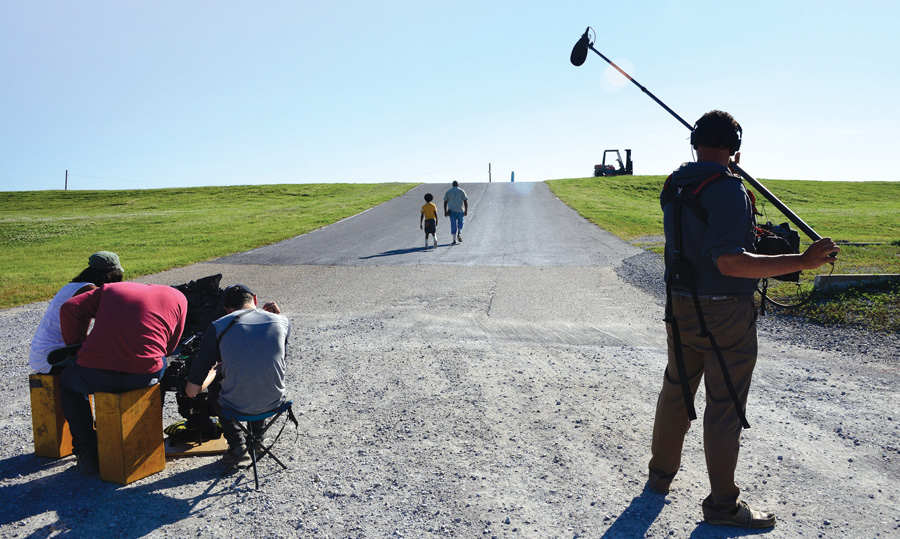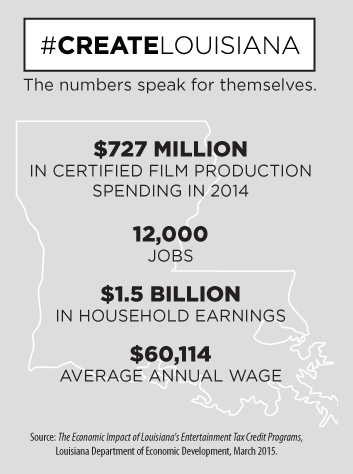Magazine
Filming Plaquemines
Nailah Jefferson directs first #CreateLouisiana-funded film
Published: October 11, 2016
Last Updated: May 2, 2019

Photo by Jason Affolder
(L to R): Director Nailah Jefferson and crew members Jake Springfield, Ben Long, and Donovan Thibodaux get in position to film actors Ari Neville and Terence Rosemore on the set on Plaquemines.
But a closer look revealed the unusual stirrings. A collection of cameras stood in a cluster at the bow of one shrimper. Young men in baseball caps fussed over cables and lighting kits. The line of vehicles in the parking lot included a minivan-turned-wardrobe, home to eight hooded sweatshirts dyed burnt orange. Three women and a child moved between an RV and the remains of a lunch buffet. These weren’t fishermen: they were here to shoot a movie.

Actor Ari Neville on the set of Plaquemines. Ari plays the character of Ethan as a young boy. Photo by Jason Affolder
The day marked the end of the shooting schedule for “Plaquemines,” a short feature directed by Nailah Jefferson, produced by Jon Wood, and funded by #CreateLouisiana, a partnership of Deep South Studios, New Orleans Film Society (NOFS) and the Louisiana Endowment for the Humanities. Jefferson’s 2014 documentary “Vanishing Pearls” chronicled the struggles of African American oystermen in Pointe à la Hache following the 2010 Deepwater Horizon oil spill. The film is particularly intimate, a product of Jefferson’s care for her subjects and the historic circumstances that surrounded them. For “Plaquemines,” she returned to the east bank of the Mississippi River with a full crew and a cast of experienced actors to tell a fictional story of a shrimping family struggling to stay together.
“I definitely felt a responsibility to the people in Plaquemines and Pointe à la Hache to be responsive and sensitive and make sure it was executed professionally and beautifully,” says Jefferson. During final day of production, the atmosphere on set reflected the bonds between the filmmaker and the community.
Byron Encalade was the focus of “Vanishing Pearls.” As he drove around the marina, he praised Jefferson. “That documentary resulted directly and indirectly in shrimpers getting a whole lot better deal from BP,” he says. “I’ll do whatever I can to help her.” Currently the head of the Louisiana Oystermen’s Association, Encalade worked with the Beshel family to accommodate the shoot, made his boats available for the film and served as the inspiration for one of the main characters, Reve, played by Terence Rosemore.
Rosemore is a New Orleans native whose screen credits include “Treme,” “The Apostle” and a prominent role in the upcoming “Guardians of the Galaxy, Vol. 2.” In “Plaquemines” he plays a father fighting to hold onto his way of life and his son, played in youth by Ari Neville and as a young man by Jaren Mitchell. Rosemore’s family has roots in the parish, and he counts Encalade among his distant cousins. “To be honest with you, everybody down here is probably related,” he says. “I’m just proud to be part of documenting this culture.”
Filmed on a modest budget, “Plaquemines” focuses on getting it right, on capturing the nuances of life in south Louisiana that sometimes disappear in multimillion dollar productions.
“I didn’t want these people to be caricatures,” says Jefferson. “I wanted them to be dignified. I feel like a lot of times people just focus on the party nature down here, or how carefree we seem, but this is real, hard work. This is life’s work, this is family, this is identity.”
Jefferson’s story of dignity and family dovetailed with the motivations of the #CreateLouisiana partners. Conceived as a way to support the state’s indigenous film community, #CreateLouisiana launched in September 2015 when Deep South’s Scott Niemeyer and Sian McArthur joined with NOFS and the LEH to offer a $50,000 grant opportunity for local filmmakers. Applicants were required to be Louisiana residents and only short films were eligible for the grant. More than 30 director-producer teams submitted applications and scripts to a committee of reviewers. Three finalists presented their work to the committee during the 2015 New Orleans Film Festival. As the winning team, Jefferson and Wood received the grant, plus mentorship from the experienced producers at Deep South. Niemeyer, a New Orleans native, continues to praise Jefferson’s commitment to Pointe à la Hache.
“Create Louisiana emerged from our belief in the talent and creativity of Louisiana’s film community,” Niemeyer says. “It’s been gratifying for us to work with Nailah, someone who places so much importance on authenticity in telling the stories of the people in Plaquemines Parish.”

The film is set to debut on Oct. 14 at the 2016 New Orleans Film Festival. For NOFS Executive Director Jolene Pinder, the grant deepens the organization’s impact in Louisiana. “We can’t wait to showcase this film and the team behind it at this year’s festival. The whole process has certainly propelled us to seek out new ways in which we can support filmmakers in the future.”
Post-production was set to wrap in August. The film employed more than 20 people on set, including crew and actors, plus two visual effects editors, a composer, two sound engineers and a colorist. Once complete, “Plaquemines” will qualify for a Louisiana film tax credit, due to a recently lowered threshold designed to support smaller-budget films. As the state debates the future of its film industry, filmmakers like Jefferson continue to chronicle life in Louisiana.
“I find this place very inspirational, and a lot of what I write is about people I’ve met, or things they’ve gone through, and a lot of them are here,” she says. “I wanted to depict a real family and what they’re trying to do to stick together.”
—–
Brian Boyles is Vice President of Content at the Louisiana Endowment for the Humanities.

